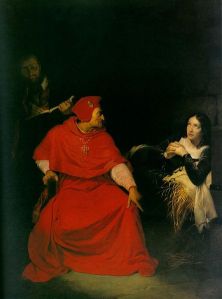Among all the multitude of queer saints, Joan of Arc is one of the most important. In her notorious martyrdom for heresy (a charge which in historical context included reference to her cross-dressing and defiance of socially approved gender roles), she is a reminder of the great persecution of sexual and gender minorities by the Inquisition, directly or at their instigation. In LGBT Christian history, "martyrs" applies not only to those martyred by the church, but also to those martyred by the church. In her rehabilitation and canonization, she is a reminder that the leaders and theologians of the church, those who were responsible for her prosecution and conviction, can be wrong, can be pronounced to be wrong, and can in time have their judgements overturned.(This is not just a personal view. Pope Benedict has made some very pointed remarks of his own to this effect, while speaking about Joan of Arc). In the same way, it is entirely possible (I believe likely) that the current dogmatic verdict of Vatican orthodoxy which condemns our relationships will also in time be rejected. We may even come to see some of the pioneers of gay theology, who have in effect endured a kind of professional martyrdom for their honesty and courage, rehabilitated and honoured by the Church, just as St Joan has been.
 |
| Joan of Arc: Interrogation by the Bishop of Winchester (Paul Delaroche, 1797 -1856) |
Joan of Arc is the best known cross-dresser in history, defying gender expectations to lead an army, and lead it to victory in the service of her country. This much is well known, and immediately qualifies her as a trans hero (or heroine. Take your pick.) What of the ret of us? Well, remember her story in the church as well as the battlefield: she was burned as a heretic, before her later rehabilitation and eventual canonization. Now recall the association of heresy and “sodomy”.
John Boswell has clearly shown that the religious opposition to homoerotic relationships was not based in scripture, nor was it deeply entrenched in the early church. Instead, the opposition of the church followed, not led, popular intolerance that grew with the decline in urbanisation after the sack of Rome. This growth in intolerance was not only directed at homosexuals, but also at other social outsiders – jews, gypsies and “heretics”. Writers such as Mark D Jordan and Allan Bray have since shown how the very word “sodomite”, now widely used as a pejorative epithet against gay males, was a late medieval coinage which was originally used far more loosely and indiscriminately, often including ay other form of sexual non-conformism – or heresy.
So what was the crime of “heresy” of which she was accused? Well, nominally it was based on her claim to have seen “visions” which inspired her to follow her path of resistance to the foreign invaders. But note the nationality of her accusers: it was not the French Church which tried and judged her, but the English Bishops: countrymen of the army she had opposed and defeated. Was her crime to have experienced visions, or was it to have opposed the English?

Joan of Arc at the Coronation of Charles VII: Ingres
Consider that which has made her most famous, iconic as an historic figure: the cross-dressing. This was a clear violation of her expected gender role, and may have been described by some as “sodomy” – which was closely related to heresy. I have recently seen a claim (sadly, I have no link) that the real reason for her trial and execution was this cross-dressing. If so, she is the first Christian martyr we know of who was executed not just executed and was gay, but executed because of her gender expression. However, there is of course a happy ending: she was later rehabilitated, and canonized. Now consider the obvious moral for us as GLBT Christians today.
Joan had a “vision”, an apparition of Mary. There are also other kinds of vision, some more mundane, more political, of the Martin Luther King “I have a dream”. In this sense, many of us too have a vision, a dream, of proper inclusion and acceptance in the Christian churches, where we belong with everybody else, on the strength of the promises of Christ.
Joan was persecuted by the church authorities, condemned and executed. We are not (directly) executed by the church today, but we are certainly condemned and persecuted, labelled as “fundamentally disordered”, and told that if we simply live truthfully in our god-given sexuality,we are committing “grave sin”. Worse, by the clear failure to take a strong stand against civil laws and proscriptions, as for example the failure to sign the UN resolution on the decriminalisation of homosexuality early this year, the Church is indirectly giving support to some forces that do actively seek our death.
But in the end, she was vindicated. We have not yet seen that development, but I am certain it will come. It is required by the Gospel of inclusion and social justice, it is also required by the internal logic of theology. James Alison has recently noted that theology will in time be forced to face up to the plain finings of science that same sex relationships are not unnatural, just uncommon. They have occurred throughout history, in many societies, and across the animal kingdom. Theologians will be slow to catch up, but they will, and we too will be vindicated.
St Joan of Arc and the queer community: we have a lot in common.
Further reading;
Bray, Alan : Homosexuality in Renaissance England
Jordan, Mark D : The Invention of Sodomy in Christian Theology
- Pope Benedict, On the Queer Lessons in the Church’s Martyrdom of St Joan.
- Trans in Faith: Some Cross-Dressing Saints & Martyrs.
- Lest We Forget: The Ashes of Our Martyrs
- "Conscience is the Highest Norm" (The Wild Reed)

